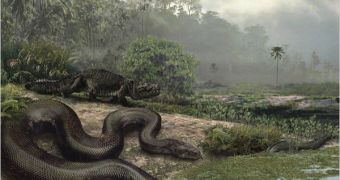It's official! The oldest snake fossils known to date belong to those of a new species, whose fossils have been discovered in Colombia. The animal named Titanoboa cerrejonensis (the titan boa) is a predecessor of today's boa constrictor, one of the largest snakes in the world. Its ancestor had a length of 42 feet, weighed up to a ton, and lived more than 60 million years ago, after the disappearance of the dinosaurs. The snake was apparently a force to reckon with, as discoverers say that it's main course was crocodile meat, and the only way to get it was to actually go out and eat a crocodile.
Besides shedding some light on the evolution of snakes to their modern adaptations, the new find also offers a priceless insight into how the rain forests handled the climate at the time, as it's a well known fact that all those years ago the planet was a lot warmer than it is today. Experts say that it's reassuring to learn that the forests are able to withstand increased temperatures. This discovery will most likely calm those who maintain that the current level of emissions will result in the drying up of the rain forest.
The fossils of Titanoboa have been found in northeast Colombia, in an open-pit coal mine, and those called to investigate the bones have noticed that the vertebrae looked like those of a snake, but that they were also severely over-sized. Studies conducted on the remains afterwards have proved the age of the remains, as well as the implications they generated.
Some 60 million years ago, the climate around the tropic was very warm and very moist, with rain falling down almost every day. As the dinosaurs were gone, all the animals that remained were ancestors to species found today in the world. The giant snake most likely devolved into the boa, becoming slightly less larger and heavier, but adapting better to living in trees and strangling its prey to death.
J. Head, a paleontologist at the University of Toronto, is the main author of the new paper, which details the finding of the new giant snake in the Tuesday issue of the journal Nature. The team is now analyzing the green anaconda, which is now the largest living tropical snake that is similar to the Titanoboa, in order to determine what the temperatures must have been 60 million years ago, so that the old snake could grow to such impressive sizes.

 14 DAY TRIAL //
14 DAY TRIAL //